- The Great Grain Debate: What’s Best for Your Dog?
- Understanding the Diets: Grain-Free vs. Grain-Inclusive
- The Health Controversy: DCM and Dietary Concerns
- Comparing Top-Rated Grain-Free Options on Amazon
- Comparing Top-Rated Grain-Inclusive Options on Amazon
- Beyond the Basics: What About Limited Ingredient Diets (LID)?
- Final Verdict: How to Make the Right Choice
The Great Grain Debate: What’s Best for Your Dog?
Choosing the right dog food is one of the most critical decisions a pet owner can make. Walking down the pet food aisle or browsing online reveals a dizzying array of options, with one of the most prominent debates centering on a single question: grain-free or grain-inclusive? Marketing campaigns have fueled a perception that grains are unhealthy “fillers,” leading to a surge in grain-free diets. However, veterinary science offers a more nuanced perspective.
This guide will break down the differences between these two dietary philosophies, explore the health considerations, and compare some of the best-selling grain-free and grain-inclusive options available on Amazon to help you make an informed decision for your furry family member.
Understanding the Diets: Grain-Free vs. Grain-Inclusive
Before diving into specific products, it’s essential to understand what these terms actually mean.
What Is Grain-Free Dog Food?
A grain-free diet is exactly what it sounds like: a dog food formulated without common grains such as wheat, corn, rice, barley, or soy. To provide the necessary carbohydrates for energy, these formulas use alternative sources. According to Purina, these often include potatoes, sweet potatoes, peas, lentils, and chickpeas. The popularity of these diets grew from the idea that they more closely mimic a dog’s ancestral diet and are better for dogs with allergies.
What Is Grain-Inclusive Dog Food?
Grain-inclusive, or “regular,” dog food contains wholesome grains that serve as a valuable source of nutrients. Contrary to the “filler” myth, grains provide essential benefits. As explained by Purina’s Chief Veterinary Officer, Dr. Kurt Venator, grains are an excellent source of carbohydrates for energy, fiber for digestive health, and even protein and essential fatty acids. For the vast majority of dogs, grains are a healthy and beneficial part of a balanced diet.
The Health Controversy: DCM and Dietary Concerns
The grain-free trend faced a significant challenge starting in 2018, when the U.S. Food and Drug Administration (FDA) began investigating a potential link between certain diets and a serious heart condition called canine dilated cardiomyopathy (DCM). DCM causes the heart muscle to thin and weaken, potentially leading to heart failure. The investigation noted that many reported cases involved dogs eating diets where legumes (like peas and lentils) or potatoes were primary ingredients—hallmarks of many grain-free formulas. FDA Investigation into Potential Link between Certain Diets and Canine Dilated Cardiomyopathy.
Veterinary experts now believe the issue may not be the absence of grains itself, but rather the high concentration of these alternative ingredients or other unknown dietary factors. Healthy Pet Veterinary Clinic notes that diet-related DCM is a complex issue with ongoing research. The consensus among veterinarians is clear:
The grain vs. grain-free dog food debate is ongoing. There is no concrete evidence to support the promotion of one diet over another currently. This means each pet parent needs to weigh the current evidence and partner this information with the health and breed of their dog. The most crucial step is to consult with your veterinarian to choose a diet that is appropriate for your pet’s specific needs.
It’s also important to distinguish a true food allergy from an intolerance. Experts at Texas A&M University’s veterinary school point out that true dietary allergies in dogs are most often caused by protein sources (like beef or chicken), not grains. Grains Or No Grains: Addressing Pet Owner Concerns.
Comparing Top-Rated Grain-Free Options on Amazon
For owners who, in consultation with their vet, decide a grain-free diet is appropriate, Amazon offers many highly-rated choices. These formulas prioritize high-quality animal protein and use alternative carbohydrates.
Blue Buffalo Freedom Grain-Free
The Blue Buffalo Freedom line is a popular choice for pet parents seeking a diet free of grains and gluten. The recipes start with real meat as the first ingredient and are enhanced with vitamins, minerals, and antioxidants. The brand emphasizes its commitment to natural ingredients, with no poultry by-product meals, corn, wheat, or soy.
- Primary Protein: Deboned beef, chicken, or lamb is the #1 ingredient.
- Carbohydrate Sources: Potatoes, peas, and tapioca starch.
- Key Features: Contains Omega 3 & 6 fatty acids for skin and coat health, and glucosamine for joint support.
- Guaranteed Analysis (Beef Recipe): Crude Protein 24.0% min, Crude Fat 14.0% min. Blue Buffalo Freedom Guaranteed Analysis.
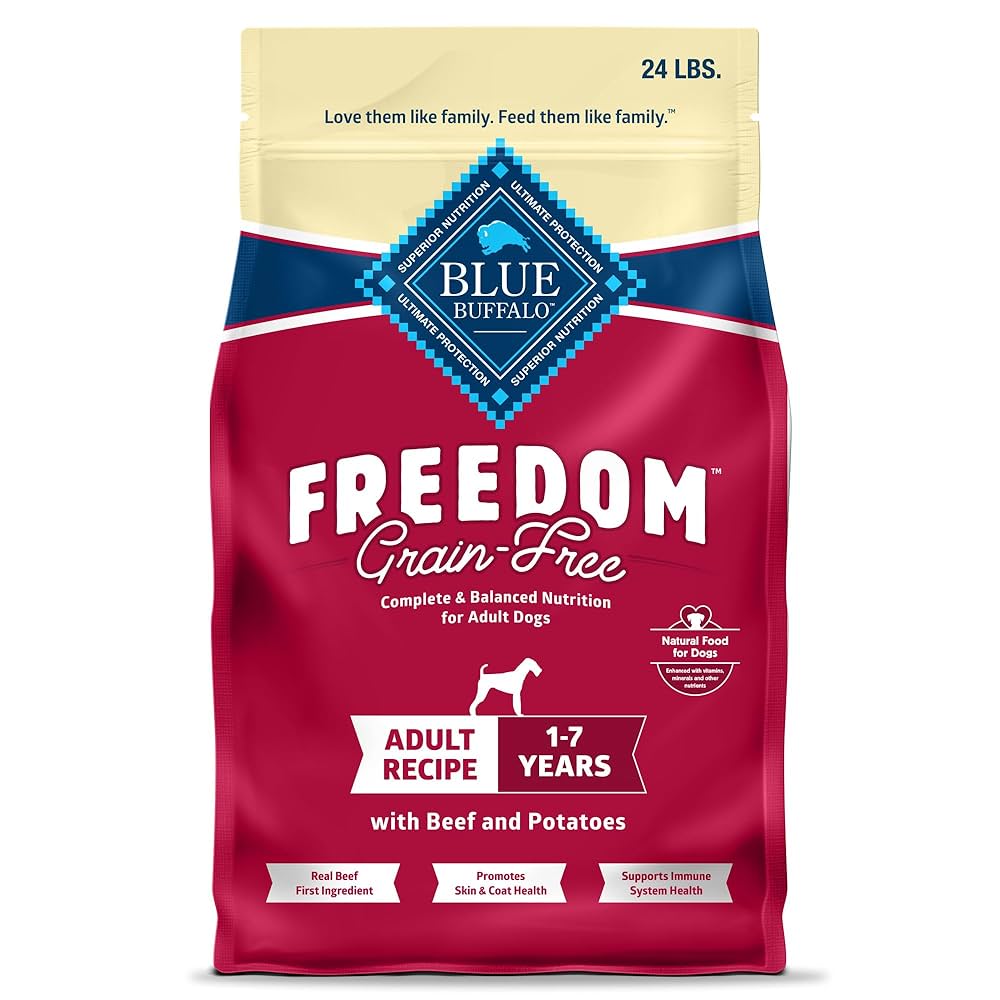
Nature’s Recipe Grain-Free
Nature’;s Recipe offers a grain-free formula that has been on the market since 1982. It focuses on providing nutrient-dense carbohydrate sources to complement its primary protein. The Salmon, Sweet Potato & Pumpkin recipe is particularly popular for its digestibility.
- Primary Protein: Real salmon is the #1 ingredient, providing Omega fatty acids.
- Carbohydrate Sources: Sweet potato and pumpkin, which are excellent sources of fiber.
- Key Features: Formulated to support digestion and immune system health. Contains no added corn, wheat, soy, or artificial flavors and preservatives. Nature’s Recipe Product Description.
- Guaranteed Analysis (Salmon Recipe): Crude Protein 25.0% min, Crude Fat 12.0% min. Nature’s Recipe Guaranteed Analysis.
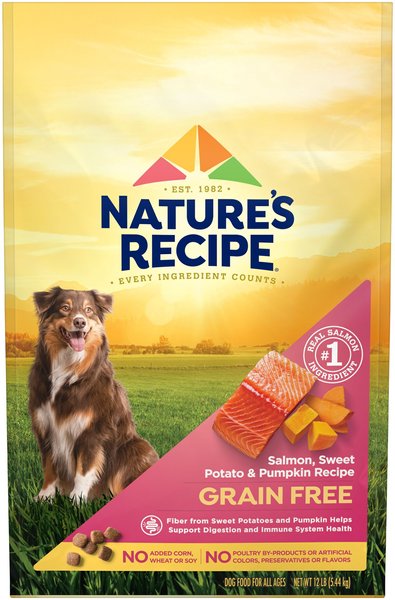
Other Notable Grain-Free Brands
Many other reputable brands offer excellent grain-free options on Amazon, including:
- Taste of the Wild: Known for its formulas featuring novel proteins like roasted bison and venison.
- Merrick: Offers premium grain-free recipes, including their Backcountry line which incorporates freeze-dried raw pieces.
- Amazon Brand – Wag: A budget-friendly option with real meat as the first ingredient and formulated without grain.
Comparing Top-Rated Grain-Inclusive Options on Amazon
For most dogs, a high-quality, grain-inclusive diet is an excellent and often veterinarian-preferred choice. These foods use digestible grains to provide balanced nutrition.
Blue Buffalo Life Protection Formula
As a counterpart to their Freedom line, Blue Buffalo’;s Life Protection Formula is their flagship grain-inclusive product. It’s formulated for overall health and well-being, starting with real meat and including wholesome whole grains, garden vegetables, and fruit.
- Primary Protein: High-quality deboned chicken, lamb, or fish is the #1 ingredient.
- Carbohydrate Sources: Brown rice, barley, and oatmeal.
- Key Features: Includes Blue’s exclusive “LifeSource Bits,” a precise blend of antioxidants, vitamins, and minerals. Blue Buffalo LifeSource Bits.
- Guaranteed Analysis (Chicken & Brown Rice): Crude Protein 24.0% min, Crude Fat 14.0% min. Blue Buffalo Life Protection Guaranteed Analysis.
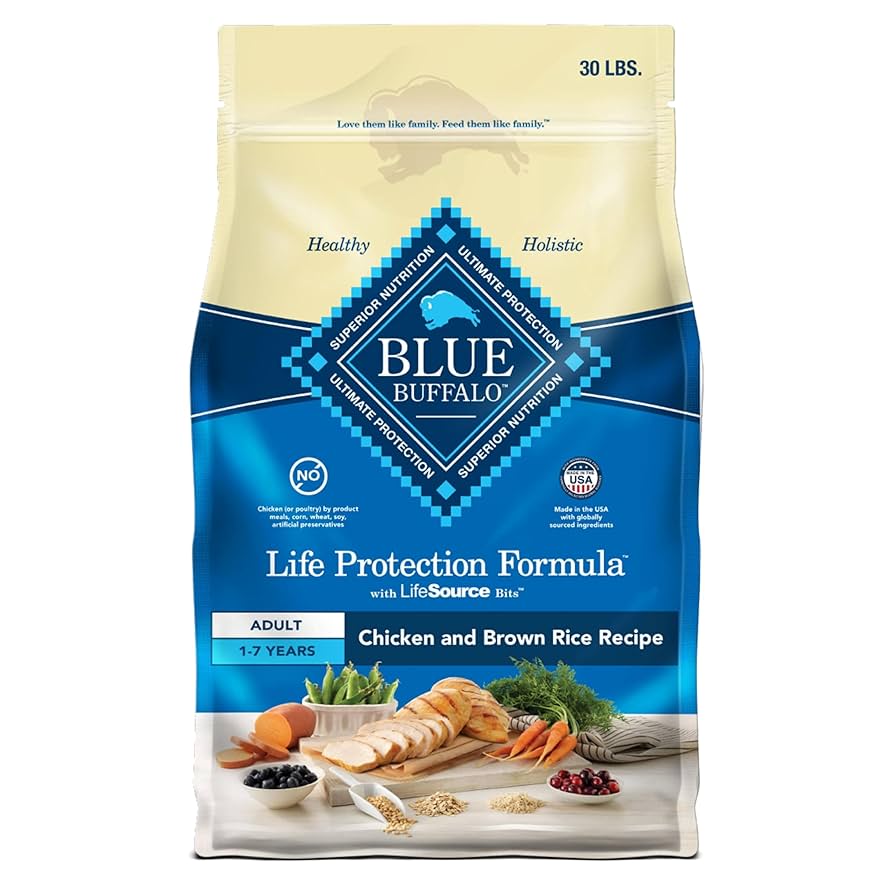
Purina ONE SmartBlend
Purina ONE combines nature and research to create formulas that support whole-body health. Their SmartBlend line features real meat as the primary ingredient and is designed to be highly digestible. The brand emphasizes its support for a healthy digestive microbiome.
- Primary Protein: Real chicken, turkey, or lamb is the #1 ingredient.
- Carbohydrate Sources: Rice, oatmeal, and other grains.
- Key Features: Often recommended by veterinarians, it contains a blend of protein, vitamins, and minerals for a healthy heart and strong muscles. Many formulas include prebiotic fiber.
- Guaranteed Analysis (Dry Chicken & Rice): Crude Protein 26.0% min, Crude Fat 16.0% min. Purina ONE Guaranteed Analysis PDF.
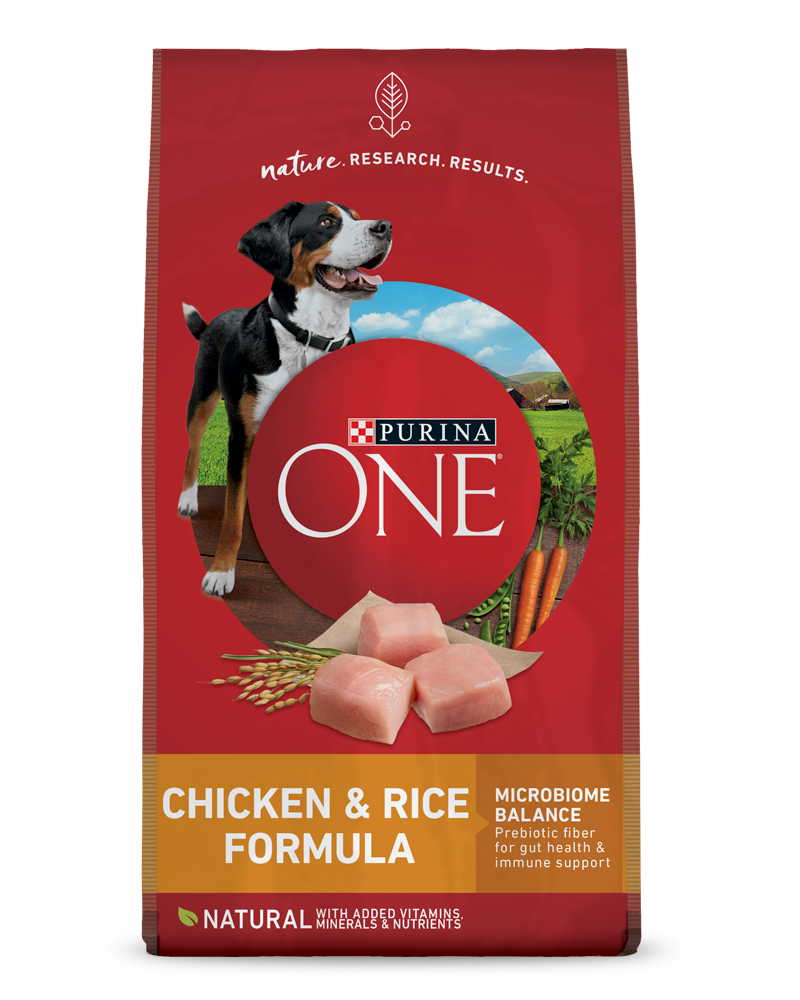
Veterinarian-Recommended Staples: Purina Pro Plan & Hill’s Science Diet
As seen in the sales chart, Purina Pro Plan and Hill’s Science Diet are market powerhouses. Veterinarians frequently recommend these brands because they invest heavily in scientific research, conduct extensive feeding trials, and employ veterinary nutritionists to formulate their diets. PetMD Vet Recommendations. Their top-selling formulas, like the “Sensitive Skin & Stomach” lines, use easily digestible ingredients like salmon, oatmeal, and rice to provide complete nutrition while addressing common health issues.
Beyond the Basics: What About Limited Ingredient Diets (LID)?
It’s easy to confuse “grain-free” with “Limited Ingredient Diet” (LID), but they serve different purposes. An LID is designed with a single source of animal protein and a single source of carbohydrate. Its primary function is to help veterinarians diagnose food allergies through an elimination trial. Canidae on LID Benefits. While many LIDs are also grain-free, their goal is simplicity to isolate potential allergens. An LID should typically be used under veterinary supervision and isn’t necessarily “better” for a dog without specific sensitivities.
Final Verdict: How to Make the Right Choice
The “grain-free vs. grain-inclusive” debate doesn’;t have a simple winner. The marketing that propelled grain-free diets to popularity has been met with scientific scrutiny, particularly regarding the potential link to DCM. For most dogs, high-quality grains are a beneficial part of a balanced diet.
Ultimately, the best food for your dog is one that meets their individual nutritional needs, is made by a reputable manufacturer, and fits your budget. The single most important step you can take is to ignore the marketing hype and have an open conversation with your veterinarian.
Always consult your veterinarian. They are the best resource for recommending a diet based on your dog’s age, breed, activity level, and overall health profile. They can help you navigate the labels and make a choice grounded in science, not trends.
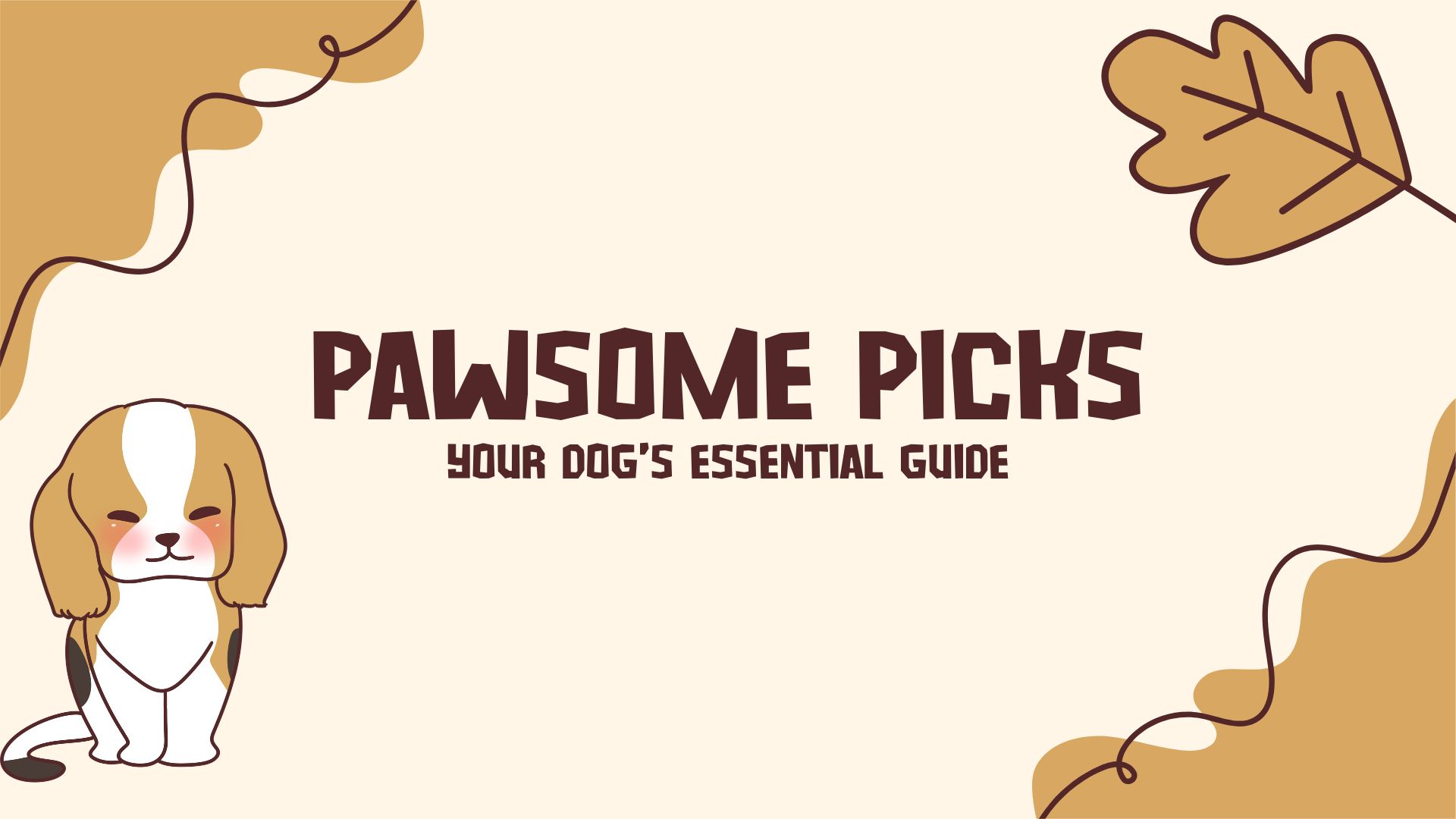

Comments